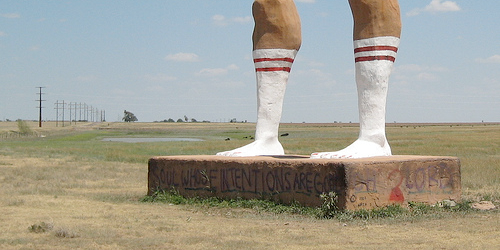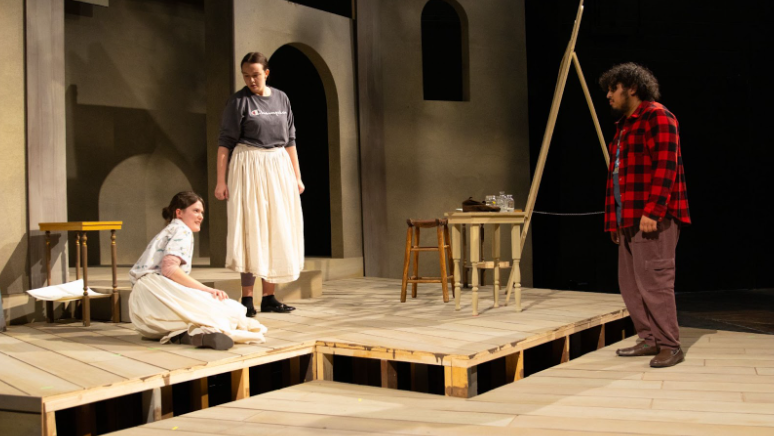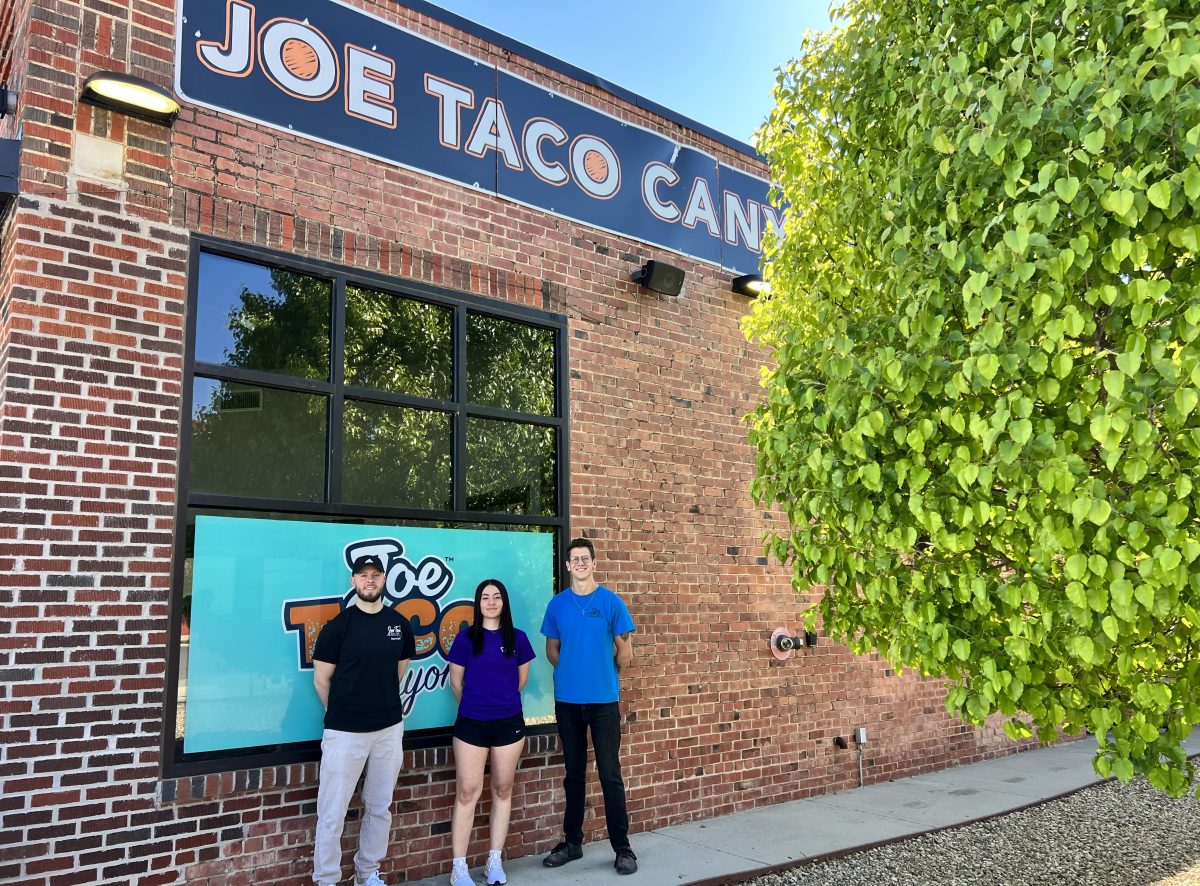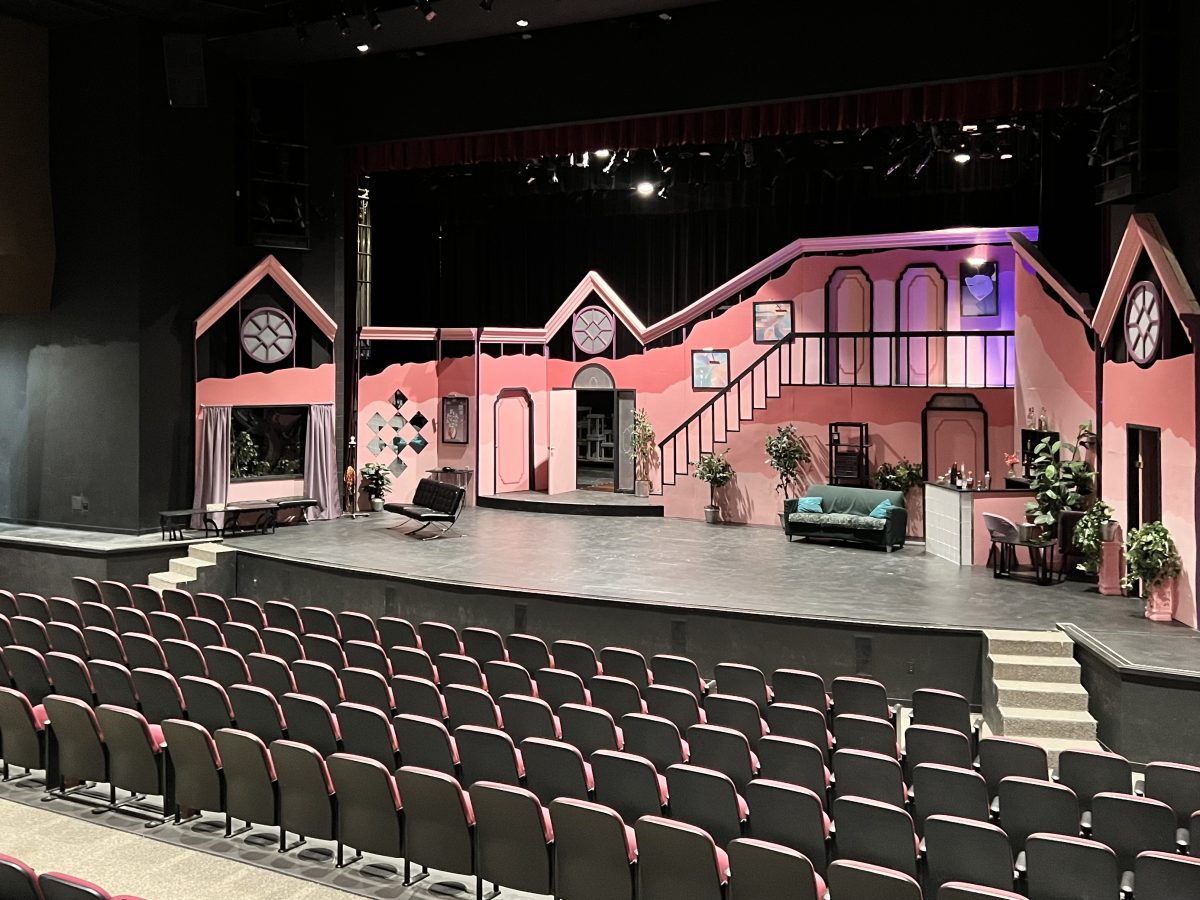
The sculpture Ozymandias is a work of public art commissioned by Stanley Marsh 3 and created by Lightnin’ McDuff. The piece is located at I-27 and Sundown Lane, just south of Amarillo in the northwest corner of a cow pasture. My first impression upon seeing the giant stone legs for the first time in person was that of disappointment, both in the scale of the sculpture and in the atmosphere created by the surrounding landscape.
First, the area was littered with debris. The sculpture’s placement also lacked emphasis, as it was tucked behind and almost hidden by the Sundown overpass. I was pleasantly surprised, however, to find that the sculpture was made to look as though it was carved out of stone, rather than the plastic or clay I had imagined. It was painted the same shade of golden red-brown as the typical Panhandle dirt found in the area’s canyons. It was raised off the ground several feet by a square pedestal of the same coloring. Since the sculpture was placed in a cow pasture, there was a barbed wire fence separating it from the viewer and preventing him or her from easily walking around the work or drawing very close.
Unlike some Land Art pieces, Ozymandias is not entirely accessible to the public. But for those with sharp enough eyes to catch a glimpse of it along the highway, who might be curious and want to take a closer look, it is out in the open and available for viewing.
In all the years I had heard of this sculpture, it was always described as “those giant legs” or something similarly vague. It was rarely identified by its real name, and no one had ever mentioned to me the concrete and metal plaque that is also part of the work. Clearly not an accident, this plaque, placed in typical “point-of-interest” fashion in front of the work, provides an interesting explanation of the piece. It offers an excerpt from a poem, as well as information that describes the age and historical importance of those stone feet.
It explains how the poem Ozymandias was written by Percy Bysshe Shelley, then quotes from Shelley’s work: “Two vast and trunkless legs of stone stand in the desert, near them, on the sand, half sunk, a shattered visage lies.” This was the line that inspired the sculpture of the two “vast and trunkless legs.” But later lines in the poem better catch the spirit of this “wannabe” monument:
“‘My name is Ozymandias, King of Kings: Look on my works, ye mighty, and despair!’ Nothing beside remains. Round the decay of that colossal wreck, boundless and bare the lone and level sands stretch far away.”
These lines reveal the reason why the sculpture was not placed in downtown Amarillo, but instead in a more remote cow pasture. Moreover, the poem helps explain another message of the sculpture: it was meant to remind people that the great and powerful, whether people or things, cannot last forever, despite how hard one tries to immortalize them. The sculpture takes this idea a step further, with the plaque’s conclusion:
The visage (or face) was damaged by students from Lubbock after losing to Amarillo in a competition. A stone cast of it will be replaced when it is ready. The original is on display now in the Amarillo Museum of Natural History. Souvenir hunters have scraped off the bottom of the pedestal. Archaeologists have determined it was as Shelley described it.
When I first began to read the plaque, its “joke” was not apparent to me. It was not until I read the last part that I realized the satirical nature of the work.
The plaque attempts to make the viewer think that the stone feet were here long before they were actually constructed and that Shelley’s poem was written for the stone legs, rather than the stone legs being created from the much earlier poem. At first, I looked poorly on the plaque and its “fake” message, but the more I thought it over, the more I began to have a deeper respect for the whole sculpture. I left with the realization that the legs were not the real focus of the art piece, but rather one element in a more complex work. The plaque and the poem were the real focus, easily missed by those who give the work only a passing glance. The true value in Ozymandias was conceptual. While many people might see this sculpture as merely a passing curiosity or the commission of a wealthy eccentric, the playful concept at the heart of the work is the true power of the piece.
When I viewed the work, there was graffiti on the pedestal and red paint colored the toenails of the giant feet, adding another layer of playfulness to the sculpture.
Partway up the legs, there was also a difference in hue, where someone had tried to paint the infamous socks the sculpture occasionally wears back to their original color. The small, enclosed area around the plaque was littered by trash, including beer cans and bottles, plastic sacks, wrinkled papers, and few unusual items that might not have been there by chance. Several large novels were scattered around, both in the weeds, and in the mud. There was a blue sleeveless coat in fairly good condition on the barbed wire fence near a green and gold letterman’s jacket.
Both jacket and coat were neatly hung on hangers and strategically placed on the fence. If their owners had merely forgotten them, they would have been discarded on the ground in a crumpled, muddy heap, similar to a white shirt on the ground below the jacket. Instead, these jackets and novels had seemingly been placed there on purpose, a small detail that started to change my humored disregard for the land art piece into a grudging respect. I began to put all the parts together in my head: the legs, the plaque, and the discarded objects. The whole atmosphere created by the collection of these diverse items added up to more than first appearances.
To me, it meant that the great and mighty will one day be forgotten and made low, a mere fragment of their former glory.
KassiAnne is a BFA student at WTAMU majoring in glass and minoring in painting. Lightnin’ McDuff is a sculptor currently living in Amarillo. He also created one of the metal buffalo sculptures outside of Old Main.








